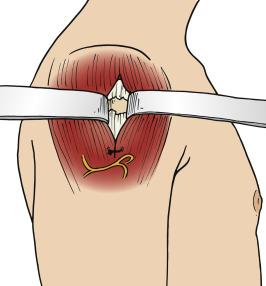Physical Address
304 North Cardinal St.
Dorchester Center, MA 02124
Open rotator cuff repair is becoming a less prevalent technique for rotator cuff surgery; nonetheless, clinical situations still arise where this technique may be preferred to arthroscopic repair. These scenarios include revision surgery for failed arthroscopic repairs and massive, chronic tears in younger and more active patients. For this reason, it is important for orthopedic surgeons to be aware of and know how to manage potential complications that may arise with open rotator cuff repair, both intraoperatively and postoperatively.
Intraoperatively, many of the potential complications are related to surgical technique and require vigilance on the part of the surgeon to prevent.
When obtaining proper exposure for the repair, the surgeon must be aware of the axillary nerve’s course and be careful not to cause a direct or traction injury. Typically, the nerve is present 5 cm distal to the deltoid origin and can be palpated as a means to identify its location. As such, a skin line is made 5 cm distal to the lateral border of the acromion as a visual cue of the typical course of the axillary nerve. Furthermore, during the split of the anterior and middle heads of the deltoid fascia, a stay suture can be placed into the deltoid proximal to the axillary nerve to avoid retraction, causing excessive splitting distally into the nerve during exposure ( Fig. 31.1 ). If a traction injury occurs, this will be recognized postoperatively by deltoid muscle atrophy. As traction injuries may resolve with time, observation is often recommended; however, direct injury to the nerve such as laceration requires repair.

In preparation of the tendon for repair, it is important to only debride degenerative tendon to healthy fibers; excessive debridement can make the repair difficult by potentially requiring medialization of the repair, placement of the repair under undue tension, or need for augmentation. Excessive resection can lead to an irreparable tendon. Identification of degenerative tendon is accomplished by assessing its overall quality via indicators such as its ability to hold suture and its visual appearance (fraying, delamination, thinning, etc.).
Become a Clinical Tree membership for Full access and enjoy Unlimited articles
If you are a member. Log in here